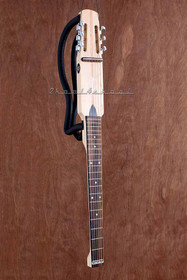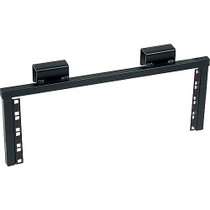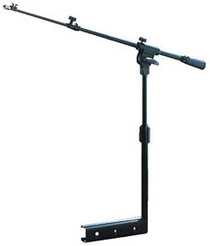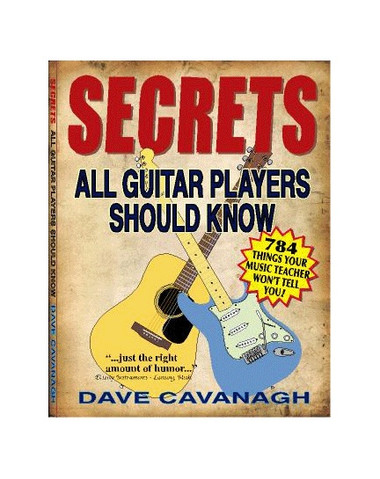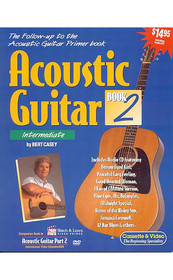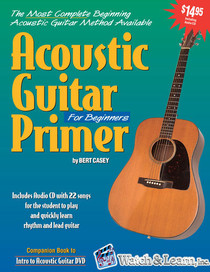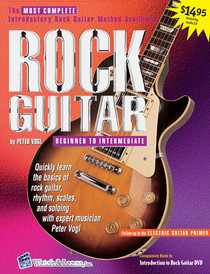- Home
- Instruction & Music
- Instruction
- Instrument Instruction Books CDs and DVDs
- Guitar Methods
- Guitar Secrets Every Player Should Know lesson book tips instruction
Categories
Current Top Sellers
Product Description
Simple concepts that all stringed instrument players need to make their music easier to produce - perfect as a teaching tool. Good for the teacher as well!
Author's note:
After doing repairs and dealing with customers in several different music stores for the last 35 years, I've found there are at least a hundred questions that I've answered a thousand times. Each.
Someone needed to write a book to inform musicians about the care and feeding of their instruments, the proper order to make adjustments and how to accurately get them (and keep them) in tune.
And, there are many ways to unintentionally do damage to instruments that people just don't know about. I see and repair stupid damage weekly. People also need to know when a repair is necessary, and when they shouldn't bother the repairman.
I suddenly realized that, with my knowledge, experience and friends in the industry, I was qualified to write such a book. So I did. It also includes other tidbits of information I thought people might want to know, like copyright stuff, stage presence advice, traveling tips, my pet peeves, et cetera.
Table of Contents
see below for excerpts from selected sections
Introduction
Care
Cleaning and Polishing
Action
Adjustments
Strings
Gauge
Composition
Longevity
Truss Rod
Relief
String Height
Inconsistency
Tuning
Intonation
Theory
Stability
Tuning Up
Temperature
Tone
Fret Wear
Choosing a Guitar
Accessories
Strap
Flat Pick
Finger Picks
Capo
Electronic Tuner
String Winders
Traveling Tips
Stage Presence
Practice
Copyright Info
Notes on Classical Guitars
Notes on Electric Guitars
Conclusion
About the Author written by Cheryl Cavanagh
Special Thanks
Contributing Editors
Glossary
Your Notes
First of all, thanks for buying my book. I hope it works for you.
I wrote it because I wished there had been something like this when I was a kid. If there had, many of the mysterious aspects of music would not have slowed me down because they wouldn't have been a mystery.
My goal is to inform students and even seasoned professionals of the many tricks that mainly only repairmen know. (I say repairmen not to suggest there aren't competent repairwomen. I just talk like that.) This is not a book on how to repair your guitar, but a book to educate you about your instrument so you will know when it needs a repair. It is also a book of musical tips and tricks to make your life as a musician easier.
With a little luck you won't have to endure that sick feeling in the pit of your stomach when you think you need new frets. Or scream in frustration because your guitar won't get in tune...
... When lubricating your tuners, use 3 in 1 oil, Singer sewing machine oil, any light oil will do. Use sparingly. One small drop at each bearing spot is enough.
There are two bearing spots on the worm gear shaft. Put a drop between the gears themselves, and one under the gear at the plate. Some tuners have a hole in the cover to admit oil.

Now take a rag and blot off any excess oil.
Remember, oil on rags is very dangerous. They can undergo spontaneous combustion - just burst into flames all by themselves. Wadding them up is what causes this. No matter how little oil you may think is on it, never wad up an oil rag. Always drape outside over...
... gook on the finished portions (the face, neck, back and sides) is water soluble too. Sweat, drool, alcoholic beverages, even blood is water soluble. Use your moistened cotton rag. You can clean the metal and plastic parts, too. Dry everything off so the moisture does not leave water spots.
If you encounter gunk that water will not remove, like leftover glue from Scotch tape, duct tape, bumper sticker adhesive, pickup mounting goo, et cetera, use "Pure Spirits of Gum Turpentine." Turpentine will dissolve glues without ...
ction
... Commonly, the word "action" is inaccurately used to describe the distance a string must be pressed to reach a fret. The height of the strings above the frets is the most obvious action factor, but many elements contribute to playability: Diameter and tautness of the strings, thickness (or thinness) of the neck, width of the fingerboard, the spacing of the strings, height of the frets, smoothness of the playing surface, et cetera.
Even the tone (or lack thereof) can influence playability. A superb instrument will audibly react to the slightest nuance of the player, making ...
... Nickel wound strings are silver in color and designed to drive the magnetic field of electric guitar pickups. They are generally not used on acoustic instruments unless a magnetic pickup is present. The inside looks like this:
80-20 Bronze wound are designed for acoustic use. Bright brass in color, and surprisingly enough, sound bright and brassy. This can be desirable if the instrument sounds dark or muddy with other strings. Unfortunately, bright strings lose their brilliance quickly, so frequent replacement is necessary.
Phosphor Bronze alloy is darker in color, and darker in tone. This can be the perfect string for bright instruments (those made of brittle hardwoods like maple or rosewood) and the harder alloy keeps its tone longer...
... A perfectly flat neck will buzz all over the place. You need just a little bow to get the frets out of the way of the vibrating string. This is called "relief." The amount of relief needed depends on the movement of the string. (Dictated by your playing style.) Bass strings need more relief than trebles. Bass guitars need quite a bit.

These graphics are grossly exaggerated for clarity. A truss rod should never be this maladjusted. You'll be surprised how little adjustment is usually required. A quarter turn of the adjustment nut will generally have the desired affect if the rod was not completely out of whack to start with.
Never overtighten the rod. If the truss rod breaks, your neck will look like the lower picture!
... No matter how good your musical ear is, if your instrument does not play in tune, you're lost.
Luthiers generally don't build instruments that won't play in tune, but through the years, things can change that affect how accurately your instruments intonate.
A quick and easy test to perform on each string is as follows:
... chime the harmonic at the twelfth fret. This splits the string exactly in half, giving you a perfect octave of the open note. The fretted note at the twelfth fret should be exactly the same note. If it is not, something is wrong.
If the fretted note is sharper (higher) than the harmonic, check the nut for wear. The string should ride through the nut slot and come free right at the beginning of the fingerboard. If the slot has worn back, then the first fret (and the entire string) is too long. A too-long string has to be a little tauter to reach pitch, so it goes sharp when fretted. Wear is usually evident by black in the slot ...
... Now that we've got your instrument playing in tune, let's get it perfectly in tune. Well, as perfect as possible. It can't really play perfectly in tune. This is because music is not mathematically perfect ...
... If you start with a "C" and tune a perfect fifth above it ... then a perfect fifth above that, and a perfect fifth above that, et cetera ... When you get back to "C" you will be noticeably sharp of "C". However, if you stack perfect fourths on top of each other, you come up flat ...
... To equalize this phenomenon you must stretch the fourths and squash the fifths. A little. Not enough to bother you, but enough to keep the octaves perfect. This modified set of notes is called "The Tempered Scale."
...Maybe you've done this: Carefully tuned an "E" chord. Perfectly. No beats. All six strings... Then played an "A" chord? Excruciating! Now you know why. Perfect intervals don't work ...
Tone is subjective. A guitar that sounds bright and clear to you may sound tinny and brash to me. This is why instrument makers cannot guarantee a guitar's tone...
...When a flute, a guitar and a piano all play the same note, say an "A" at 440 cycles per second, you can hear that one sounds like a flute, one sounds like a guitar and one like a piano. This is because they each have a different tone. (Also called "Timbre.")
Here is the reason for this. The fundamental frequency, in this case 440 cycles per second, is only the lowest frequency in the note. There are many other frequencies (called "harmonics") being produced above this fundamental. The number and volume of these other frequencies is what gives a unique timbre to that particular instrument...
... telltale sign that your frets are too worn is that they don't work properly anymore. Duh. I'm a big proponent of "If it ain't broke, don't fix it." Don't assume that if you see wear, a repair needs to be done.
Dimples in the surface of your frets do not mean they need replacing. It simply means they are getting worn...
...So, before you freak out about your fret problems, see a professional. Besides, worst case scenario, you get a new guitar! How bad is that?
... One more thing about straps: They try to drop your guitar a lot. Never trust them. Get into the habit of feeling both ends of your strap to check its mooring every time you put on your guitar. The end can easily get flipped over making it easier to jump off than stay on:

Try to have at least one hand on your instrument at all times. It may look cool and incite the audience when you clap your hands above your head, but this is exactly when your strap will fail you.
If you must do these kinds of theatrics ...
... going to avoid checking your guitar with your luggage (advisable if you think you can get away with it) a gig bag (that soft sided, padded material type of case) is actually better. They make it possible to fit in some overhead compartments. Especially electrics and smaller instruments. Big dreadnoughts still have a problem.
Most airline people understand that you don't want to check your delicate, valuable instrument and will admit there are several FAA-approved places to stow it. Behind the last row of seats is a good place. Sometimes the purser has a compartment. Actually, the captain has a big closet in the cockpit. Just talk to them. Be nice. You may be surprised.
Finally, if after you've carried it all the way into the aircraft, the flight crew insists you must check your guitar, don't despair. At this point your guitar will be hand carried to the luggage compartment (of the correct plane for sure). It will be the last thing in and the first thing out. I've even had it ...
... Surveys have found that if you ask people what their greatest fear is, most people will say "Getting up and speaking in front of a large group." The next most popular answer is "Death." So, for most of you, you would rather die than get up and perform! ...
... Stay loose. Mistakes happen. They usually aren't a problem if everyone in the band is paying attention. Just don't make a face. Ninety-nine percent of your audience will not notice a minor blunder, but if you make a face, one hundred percent will know.
If you make a really bad mistake, and you know everyone heard it, look over at the bass player and give him or her a dirty look ...
... relatively easy to register your work. You just need to send two copies off to Washington, D.C. with the required form (form PA for performing arts work or form SR to register a sound recording) and the registration fee. When this book went to press the fee was $30, but check www.copyright.gov to get the current rate. You can also download the forms and instructions from there.
You can register several songs at once (thus incurring only one $30 fee) by submitting a compilation. Just put them all together on one recording.
When you sell (or give away) any recordings, to protect your copyright, and serve notice to the general public that you intend to preserve this right, you must print on the label: The word "Copyright" or the circle c symbol (©), followed by the year you wrote the song, followed by the name of the copyright holder. Example: ©2004 Dave Cavanagh
This copyright is good for 70 years after your death. After that, your song becomes "public domain" and anybody can ...
Dave Cavanagh is more than a musician. He is an artist. Dave learned from an early age that things are as they seem. Learning how the world works from his father, he repaired his first guitar at the age of 13. During high school, he apprenticed at Cole Music in his hometown, Sonora California. Eventually, Dave owned and operated Cole Music for many years.
Dave has played music professionally for more than 35 years. He played and traveled with Randy Sparks, Burl Ives and at last count, over 22 different bands. He currently entertains crowds with Ron DeLacy in Doodoo Wah, a politically incorrect folk duo. They keep people laughing with original tunes about current events.
Dave dabbles in web design, graphic arts, stained glass, instrument building and restoration of antiques. Being familiar with turn of the century shop processes ...
... enjoys spending time with his wife and cat on the Sacramento river cruising on one of his two boats: a 45-foot houseboat and a 28-foot 1964 Chris Craft cabin cruiser.


Custom Tab
Returns Policy
You may return most new, unopened items within 30 days of delivery for a full refund. We'll also pay the return shipping costs if the return is a result of our error (you received an incorrect or defective item, etc.).
You should expect to receive your refund within four weeks of giving your package to the return shipper, however, in many cases you will receive a refund more quickly. This time period includes the transit time for us to receive your return from the shipper (5 to 10 business days), the time it takes us to process your return once we receive it (3 to 5 business days), and the time it takes your bank to process our refund request (5 to 10 business days).
If you need to return an item, simply login to your account, view the order using the "Complete Orders" link under the My Account menu and click the Return Item(s) button. We'll notify you via e-mail of your refund once we've received and processed the returned item.
Shipping
We can ship to virtually any address in the world. Note that there are restrictions on some products, and some products cannot be shipped to international destinations.
When you place an order, we will estimate shipping and delivery dates for you based on the availability of your items and the shipping options you choose. Depending on the shipping provider you choose, shipping date estimates may appear on the shipping quotes page.
Please also note that the shipping rates for many items we sell are weight-based. The weight of any such item can be found on its detail page. To reflect the policies of the shipping companies we use, all weights will be rounded up to the next full pound.
 Loading... Please wait...
Loading... Please wait...


